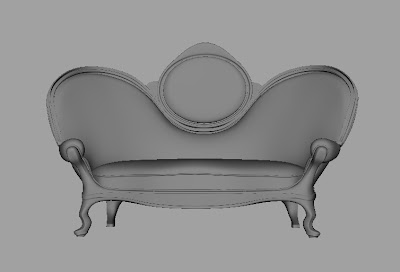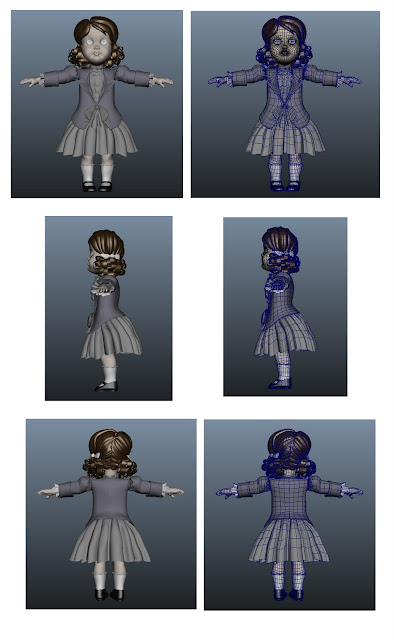Concept to Animation and all the In-betweens: Porcelain Why Paper
The Beginnings of a Story
The birth of a story concept is always the most optimistic and hopeful stage of storytelling in time based media. At this stage I fall in love with an ephemeral idea which swims around in my grey matter. It is perfect in its untouched splendor. I never know how these ideas materialize but I do know that at their birth they are as flawless as a blanket of newly fallen snow. However, as soon as my mind begins to translate this captivating idea into a reality, I create irreversible tread marks that scar the initial perfect state. The more I develop an idea, the more scars appear. The motivation to develop is to translate the ephemeral into the tangible. The untouched perfect ideas only exist in the corner of my eye where I can’t quite see them. As I develop these ideas I try to create what is not fully visible, to somehow solidify the perfection that is always just out of sight. Unfortunately, the more I develop the project, the more mutilated the concept becomes.
I find the process of translating an ephemeral concept into a corporeal film to be a destructive yet fascinating process. In this transitional stage all the whos, hows, whats and whys creep out of the foundation demanding to be answered. I am always startled at how unprepared I am to address these deceptively simple inquires. I am currently in production for a short animation called Porcelain. In writing this production journal for Porcelain I hope to do some much needed mental house cleaning as well as to more fully explore the creative process of bringing a concept to a complete animation.
The idea of Porcelain was an amalgamation of two different influences. The first was a case study I read in my sociology text book in the socialization chapter. The case was about a young girl named Anna who was locked in an attic room with essentially no human contact for five years. When Anna was eventually rescued she was “unable to laugh, smile, speak or even show anger, she was completely unresponsive, as if alone in an empty world…Although alive, Anna hardly seemed human.” (Gerber, Macionis 111) Anna’s case is an example of how social experience is the key to humanity, and that without socialization “an individual is more of an object than a person” (Gerber, Macionis 111). The story of Anna both terrified and fascinated me.
The second influence happened when I was working at a toy store. The day was particularly slow and I was flipping through an ordering catalogue when I came upon this exquisite doll house. I was very taken by the extravagant toy and debated buying it for the possibility of future children. In the end I didn’t purchasing it as I came to the conclusion that even if I did eventually have children, I knew I wouldn’t allow them to play with the doll house because it was simply too beautiful and children, no matter how careful, would most definitely spoil it.


Somehow Anna’s case and the doll house started to coagulate in the recesses of my brain and Porcelain began to formulate. I kept imagining a little girl forgotten in an environment of precious and beautiful objects that were always out of reach and eventually the girl too would become a beautiful lifeless object. Until this point in development Porcelain had not been much more than a lonely feeling combined with vague mental images, yet it felt achingly beautiful to me. My brain had been working behind my back and had sprung this concept upon me. From this moment forward developing the concept would require conscious problem solving to translate what exclusively existed in my mind into something I could share. This is the beginning of the destruction phase. As soon as I began asking myself the whos, hows, whats and whys, that beautiful concept became less and less perfect but more and more real.
Developing Story
In order to take a concept that is nothing more than feelings and vague mental images and turn it into a functioning story, I first had to distil what exactly I liked about the idea. Porcelain at this point could be summed into three main points: intense loneliness, trying to find or reach something beyond grasp and imprisoning yet beautiful objects. The loneliness and the searching fit together as the motivation for the story and the objects worked as a setting. Like Anna, I wanted my protagonist to be isolated from the outside world resulting in a lack of identity. I determined that searching for something would be the protagonist’s attempt to find her identity but never managing to do so. The beautiful objects led me to set the story in the Victorian era. I have always been fascinated by the extravagance of wealthy Victorian society, and how symbols of wealth also functioned as cages for women and children especially in terms of clothing such as corsets, gloves and high buttoned necks. The confining socialization of children in the Victorian era, with adages such as, “Children should be seen and not heard”, also helps to place and validate my protagonist’s isolation and lack of self.
I began to construct the basic plot for Porcelain into three acts. The first act establishes the protagonist, who I decided to name Anna after the poor girl from the case study, and her relationship to her surroundings. The second act illustrates her entrapment within her environment. The third act is the result of her entrapment.
The most difficult section is Act 1 because it establishes all the information needed to guide the viewer through the rest of the story. In Porcelain I had to find a way to show Anna’s isolation as well as her internal struggle to find an identity. I also needed to establish information about the beautiful objects, where they came from and why they are untouchable. After some consideration
I decided a mother character was necessary both to explain Anna’s lack of socialization as well as to be the giver of the collection of beautiful objects. After the decision of adding the mother the other two acts fell into place relatively easily and I now had a start of a story.
For some unknown and bizarre reason, stories about little girls getting turned into dolls are all the rage these days. For example, a short film call Alma has recently taken the animation world by storm. Alma is essentially about a little girl turning into a porcelain doll and whenever I pitch Porcelain somebody always mentions Alma. The concept for Porcelain first came to me sometime in 2006 and it wasn’t until 2010 that I watched Alma. Needless to say, seeing that film was a little bit defeating. In truth Alma’s overall story quite is different from Porcelain with the exception of the turning into a doll at the end. However, I still fear that my film will be dismissed as unoriginal and trendy.
Inspiration
I find Titanic to be an inspiration in how the movie portrays the confinement of Edwardian high society. There are two scenes in particular. The first takes place over afternoon tea where the protagonist Rose sits silently as her mother and her peers engage in idle chit chat concerning current wedding fashions. Rose looks over to a neighboring table and watches as a woman corrects a young girl’s posture and proceeds to teach proper tea time etiquette. The camera then focuses on Roses as she silently watches this little girl become entrapped in the same social cage that she is confined by. This scene demonstrates socialization and the construction of identity as the child is being molded to fit within a specific social role.


The second scene is a deleted scene where Rose attempts to undress herself after she leaves a dinner party in distress. Without a servant to assist, Rose cannot release herself from the beautiful yet extremely confining dress. She becomes more and more frantic and she fumbles with the multitude of straps and buttons. In this scene Rose’s dress, a symbol of her wealth literally becomes a cage that she struggles to free herself from it. The beautiful objects in Porcelain take on the same role as Rose’s dress as they work to imprison Anna.
Moving Forward and Problem Compromising
One of the most difficult problems that I am facing is how to get an audience to empathize with Anna. I originally imagine Anna to be unable to fully feel or express emotion because of her perpetual isolation. However, having a protagonist that never changes emotionally seems like a death sentence to the success of my film. When telling a story in animation it is always a good idea to completely switch the emotional state of the character within the scene. Toy Story is a great example of this. Not only do both Woody’s and Buzz’s emotional states completely change in every scene, one of the character’s feelings is always in opposition to the other, creating an extremely interesting and engaging character dynamics. Porcelain currently lacks emotional contrast which is very likely to alienate an audience. Allowing Anna to express a wider range of emotions throughout the story would probably create more dynamic and interesting scenes as well as cause the audience to identify with Anna. However, if Anna is more expressive, her loss of identity will be much more difficult to portray and I run the risk of creating a film about a magic music box opposes to the loss of self.
As I think of way to represent Anna so the audience can connect with her, my mind keeps falling back on Gayatri Spivak’s “Can the Subaltern Speak?”. The article argues that in society certain minorities are rendered silent because they do not fit within the hegemonic system. Society is built on rules determined by the ruling class, those people who function outside of these ideologies get lost or forgotten within the dominate social system. The people who fall through the cracks of society are unable to have an effect on their environment because they essentially don’t exist within hegemonic system. Spivak refers to these minorities as subaltern. The reason Anna is such a difficult character for me to represent in a relatable way is because she is subaltern. Her story is her loss of self within an environment that she has no control over. In trying to represent her I am attempting to give a voice to a character that is rendered silent. Spivak’s poses question “Can the Subaltern Speak?” and through Porcelain I am trying to find the answer.
Conclusion
The problem with passion and inspiration is the creation of precious ideas. Because at birth the idea seems so perfect, it is extremely difficult to deviate from the initial conception. To make changes to the characters, to add or drop scenes within the story, every aspect of problem solving
feels like a mutilation of something once so wonderful. However, the perfect idea is a lie. What exist so pristinely in my mind is in fact hugely flawed in reality. It is my hopeless ambition as a filmmaker to create a film that is as beautiful in reality as the original concept was when I first saw in the corner of my eye.

































